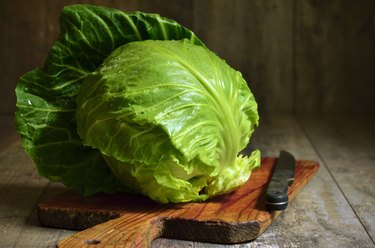
Cooking cabbage on your stove can be smelly — but doing so also reduces its nutritional value. The problem lies in sulfur-containing chemicals called isothiocyanates that stink up your kitchen and in the boiling process that can destroy the water-soluble vitamin C in cabbage.
Baking in the oven via dry heat is a nutritious and quick way to cook cabbage — and, as long as you do not overcook it, a less smelly method.
Video of the Day
Video of the Day
Things You'll Need
Cabbage
Sharp knife
Unsalted butter or plant-based alternative
Microwave-safe bowl or saucepan
Baking sheet
Parchment paper (optional)
Basting brush
Salt
Black pepper
Tongs
Fork
Instructions
- To prepare cabbage for baking, first remove the dark green outer leaves.
- Slice the cabbage head in half with a sharp kitchen knife. Slice each half in half twice so you end up with eight pieces. Stand each piece up and slice downward between the core and the cabbage. Discard the core.
- Melt 2 tbsp. of butter or margarine per head of cabbage in your microwave oven or on your stove
- Arrange cabbage pieces in a single layer on a baking sheet.
- Baste the entire surface of the cabbage pieces with butter and season with a sprinkling of salt and black pepper.
- Adjust an oven rack to the top position. Preheat your oven to 475 degrees Fahrenheit.
- Bake the cabbage for 20 to 30 minutes, turning once with tongs during this time.
- Remove the cabbage from your oven when it is just fork tender and brown spots start to appear on the surface of the cabbage pieces.
Tip
Use a stainless steel baking sheet, rather than an aluminum baking sheet, for baking cabbage in your oven. Chemical compounds in cabbage react strongly to aluminum and the result will be smelly.
If you must use an aluminum baking sheet, line it with a sheet of parchment paper as an insulating layer.